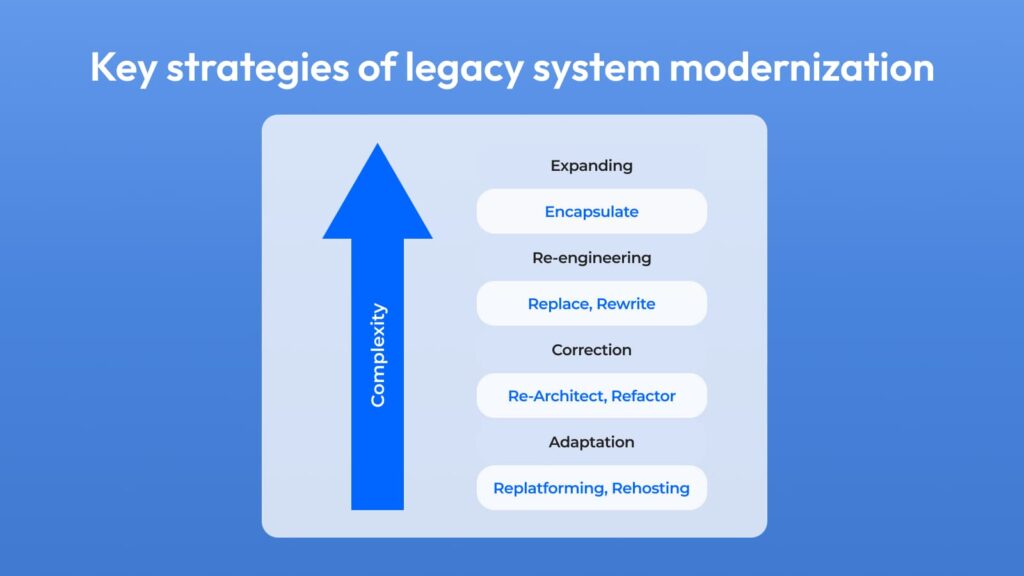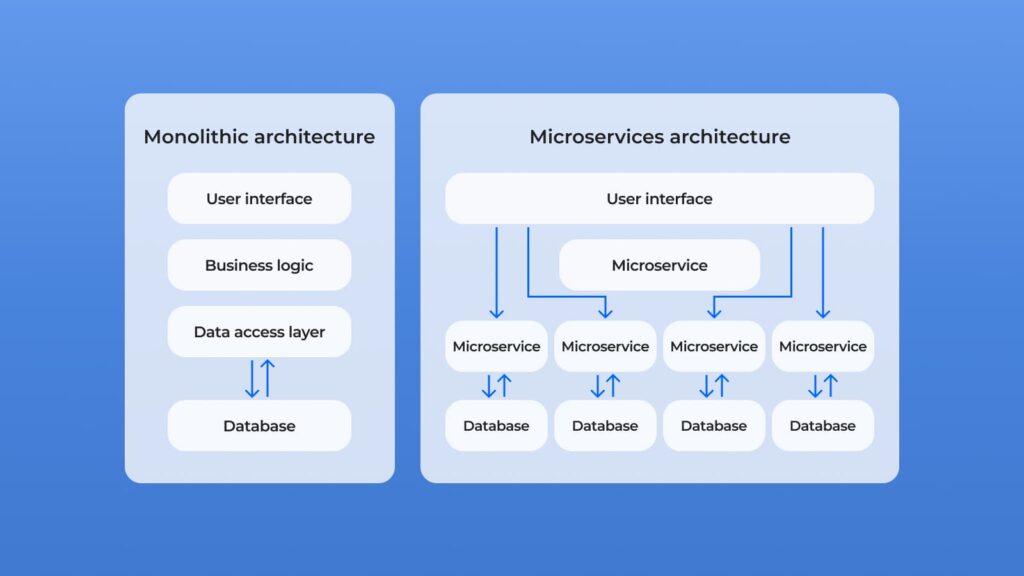Legacy systems can hinder a company’s development and ability to meet customer demands in today’s rapidly changing world. Updating old software is important to improving performance, data safety, and usability. In this article, learn all about updating outdated applications, including the signs of obsolescence and the pros and cons.
Introduction to Legacy System Modernization
Modernizing legacy systems is updating an outdated IT infrastructure to make it suitable for a company’s current needs. Businesses rely on old solutions that they are used to, but they can become inefficient and complex to maintain, resulting in the necessity to update them.
Old solutions can create cybersecurity threats, decrease your company’s performance, and limit scalability. Updating legacy apps includes improving critical software elements, integrating new tools, renewing user interfaces, improving performance, adding new data protection tools, etc. This process helps, in the long run, to improve workflow, reduce expenditures, increase data accuracy, and boost competitiveness.
Why You Need Legacy Software Modernization
Let’s examine the benefits of upgrading old software and explore the main values of this decision.
1. Better efficiency. Old apps perform much less efficiently, can be challenging to manage, and do not deliver practical results, resulting in increased operational expenditures and worse performance. Updating them can increase performance and automate your daily tasks.
2. Robust security. Legacy software is at greater risk of vulnerabilities because it lacks modern security features. Updating old systems helps organizations strengthen cybersecurity defenses and protect your data from threats.
3. Improved user experience. Customers expect smooth and convenient interactions in any software they use. Modernizing old software allows improving user interfaces, enriching functionality, and providing clients with a better overall user experience.
4. Scalability. Old applications are complex to scale because they use irrelevant technologies that cannot be improved. Modernizing these solutions will allow you to expand since it will meet growing needs.
5. Regulatory compliance. Legacy systems can have problems meeting current regulatory standards. By updating them, businesses will remain compliant with industry regulations and avoid potential legal issues.
How to Understand That You Need to Modernize Your Software
We’ve explored the pros of upgrading legacy software. But how do you know when it’s time to update your systems? Here are several key factors that indicate it’s time to consider turning to legacy software modernization services:
1. Performance degradation. If you’ve noticed worse operation of your current app, like long-time response times or many errors, it may indicate that your software can’t effectively meet your company’s needs.
2. Difficulties with new technologies. If you notice that the system cannot easily work with the current tools or solutions that can improve your operations, it may be time for renovation.
3. Security threats. Data leaks or other safety problems indicate weaknesses in your cybersecurity system, suggesting you need to upgrade to strengthen your defenses.
4. Costly maintenance. Modern software requires lower IT infrastructure cost expenditures to maintain compared to outdated ones.
5. Employee dissatisfaction. Old applications can decrease employee performance and satisfaction by causing dissatisfaction with interfaces or workarounds. Updating systems can streamline workflows and improve usability, increasing employee satisfaction.
6. Compliance problems. If your old systems are not compliant with regulatory requirements or require manual actions for compliance matters, upgrading can help avoid legal complexities and ensure adherence to industry laws.
Software Modernization Strategies
When considering software modernization strategies, it’s important to carefully assess your current systems and goals. According to your needs, you can choose one of the following strategies:

Expanding
Expanding your current software system involves adding new features or modules to enhance its functionality. This strategy is ideal for organizations building upon their existing systems rather than starting from scratch. By expanding your software, you can improve user experience, increase scalability, and meet changing business requirements more effectively.
Re-engineering
Re-engineering involves redesigning and restructuring your existing software to improve its performance, scalability, and maintainability. This strategy is beneficial for organizations with outdated or inefficient systems that require a complete overhaul. By re-engineering your software, you can address issues such as security vulnerabilities, regulatory compliance challenges, and integration with new technologies.

Correction
Legacy system correction involves architectural changes and refactoring of the existing software to improve its performance, maintainability, and scalability. This strategy focuses on identifying and fixing issues within the legacy system without completely replacing it. By correcting the architecture and refactoring the code, organizations can address security vulnerabilities, enhance integration with new technologies, and ensure compliance with regulations.
Adaption
Legacy system adaption involves modifying your existing software to fit new requirements or technologies without completely replacing it. This strategy is ideal for organizations looking to make incremental changes to their systems rather than a complete overhaul. By adapting your legacy system, you can address specific issues, integrate new features, and improve performance without requiring a complete re-engineering process.
Challenges of Legacy Systems Modernization
Upgrading legacy software improves a company’s workflow by accommodating the newest tech trends in its infrastructure. However, there are challenges in this endeavor.
One is ensuring interoperability with other software and data. Old software commonly has a complex architecture that makes simple integration with new solutions challenging and time—and resource-consuming.
Another issue when modernizing legacy software is the necessity for detailed documentation and understanding of the app’s architecture. Over time, an understanding of how your existing software works can be lost or eroded due to staff turnover. IT teams may need assistance accurately assessing the system’s current state and creating a solid modernization plan. Retraining existing staff or bringing new talent to work effectively with updated technology may also be essential.
Wrapping Up
In conclusion, legacy system modernization is necessary for enterprises aiming to remain competitive in today’s fast-paced digital landscape. By updating outdated software and processes, businesses can improve efficiency, cut expenses, boost security, and provide a better overall experience for employees and clients.
